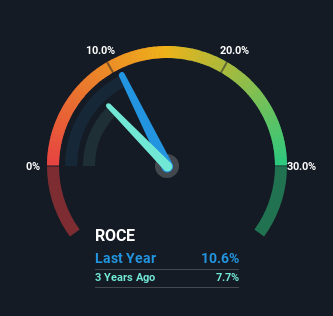- India
- /
- Auto Components
- /
- NSEI:JAYBARMARU
Here's What's Concerning About Jay Bharat Maruti's (NSE:JAYBARMARU) Returns On Capital
If we want to find a potential multi-bagger, often there are underlying trends that can provide clues. Typically, we'll want to notice a trend of growing return on capital employed (ROCE) and alongside that, an expanding base of capital employed. Ultimately, this demonstrates that it's a business that is reinvesting profits at increasing rates of return. However, after briefly looking over the numbers, we don't think Jay Bharat Maruti (NSE:JAYBARMARU) has the makings of a multi-bagger going forward, but let's have a look at why that may be.
What Is Return On Capital Employed (ROCE)?
Just to clarify if you're unsure, ROCE is a metric for evaluating how much pre-tax income (in percentage terms) a company earns on the capital invested in its business. The formula for this calculation on Jay Bharat Maruti is:
Return on Capital Employed = Earnings Before Interest and Tax (EBIT) ÷ (Total Assets - Current Liabilities)
0.11 = ₹908m ÷ (₹15b - ₹6.2b) (Based on the trailing twelve months to December 2023).
Therefore, Jay Bharat Maruti has an ROCE of 11%. In isolation, that's a pretty standard return but against the Auto Components industry average of 15%, it's not as good.
View our latest analysis for Jay Bharat Maruti

Historical performance is a great place to start when researching a stock so above you can see the gauge for Jay Bharat Maruti's ROCE against it's prior returns. If you're interested in investigating Jay Bharat Maruti's past further, check out this free graph covering Jay Bharat Maruti's past earnings, revenue and cash flow.
So How Is Jay Bharat Maruti's ROCE Trending?
When we looked at the ROCE trend at Jay Bharat Maruti, we didn't gain much confidence. To be more specific, ROCE has fallen from 17% over the last five years. On the other hand, the company has been employing more capital without a corresponding improvement in sales in the last year, which could suggest these investments are longer term plays. It's worth keeping an eye on the company's earnings from here on to see if these investments do end up contributing to the bottom line.
On a side note, Jay Bharat Maruti's current liabilities are still rather high at 42% of total assets. This effectively means that suppliers (or short-term creditors) are funding a large portion of the business, so just be aware that this can introduce some elements of risk. While it's not necessarily a bad thing, it can be beneficial if this ratio is lower.
In Conclusion...
To conclude, we've found that Jay Bharat Maruti is reinvesting in the business, but returns have been falling. Investors must think there's better things to come because the stock has knocked it out of the park, delivering a 117% gain to shareholders who have held over the last five years. However, unless these underlying trends turn more positive, we wouldn't get our hopes up too high.
If you want to know some of the risks facing Jay Bharat Maruti we've found 3 warning signs (2 are a bit unpleasant!) that you should be aware of before investing here.
For those who like to invest in solid companies, check out this free list of companies with solid balance sheets and high returns on equity.
New: Manage All Your Stock Portfolios in One Place
We've created the ultimate portfolio companion for stock investors, and it's free.
• Connect an unlimited number of Portfolios and see your total in one currency
• Be alerted to new Warning Signs or Risks via email or mobile
• Track the Fair Value of your stocks
Have feedback on this article? Concerned about the content? Get in touch with us directly. Alternatively, email editorial-team (at) simplywallst.com.
This article by Simply Wall St is general in nature. We provide commentary based on historical data and analyst forecasts only using an unbiased methodology and our articles are not intended to be financial advice. It does not constitute a recommendation to buy or sell any stock, and does not take account of your objectives, or your financial situation. We aim to bring you long-term focused analysis driven by fundamental data. Note that our analysis may not factor in the latest price-sensitive company announcements or qualitative material. Simply Wall St has no position in any stocks mentioned.
About NSEI:JAYBARMARU
Jay Bharat Maruti
Manufactures and sells auto components and assembly systems in India.
Solid track record second-rate dividend payer.
Market Insights
Community Narratives


Recently Updated Narratives


Engineered for Stability. Positioned for Growth.


MINISO's fair value is projected at 26.69 with an anticipated PE ratio shift of 20x


Fiverr International will transform the freelance industry with AI-powered growth
Popular Narratives


MicroVision will explode future revenue by 380.37% with a vision towards success


NVDA: Expanding AI Demand Will Drive Major Data Center Investments Through 2026



